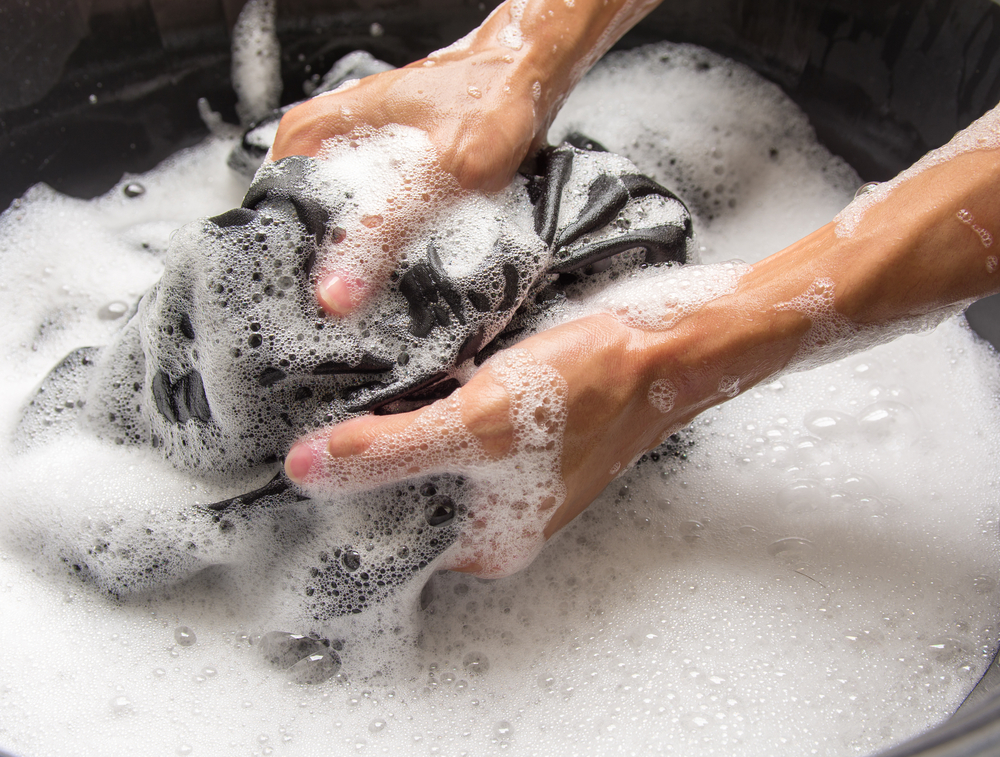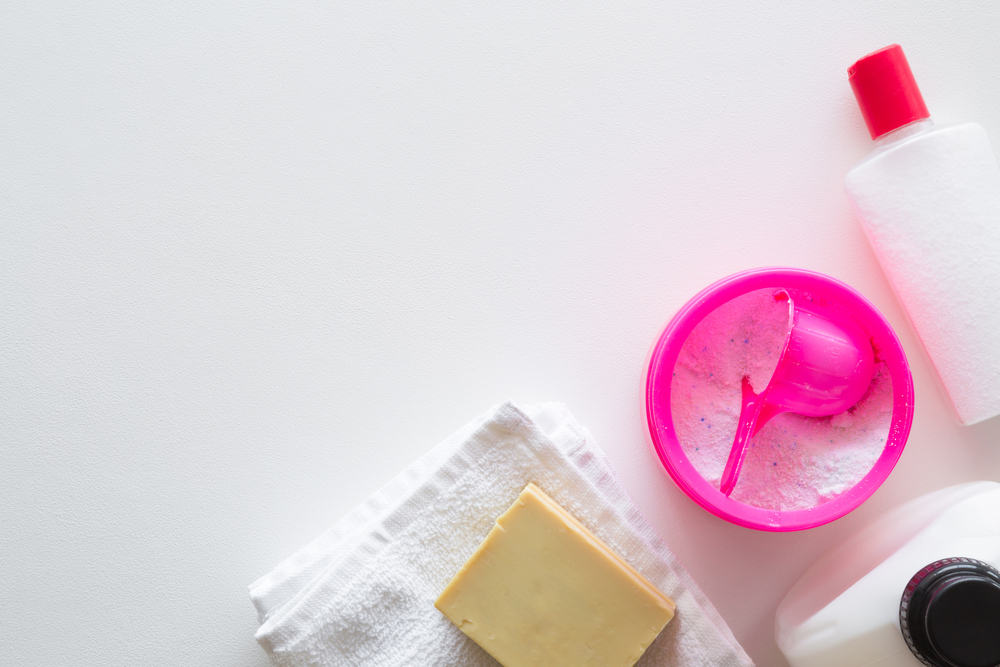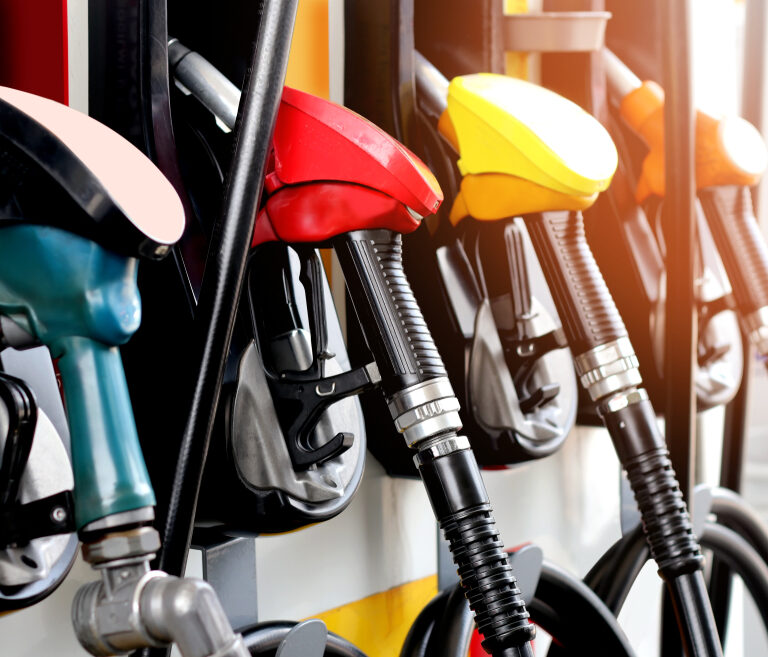Anyone who regularly works with cars or uses gasoline for DIY projects around the home, such as removing grease stains or scuff marks, probably knows the frustration of accidentally spilling gasoline somewhere on your clothing. Not only is a stain usually left behind, there is the strong odor of gasoline as well!
Fortunately, it is possible to completely remove gasoline stains and odors from your clothing. In this article, we will discuss cleaning materials, the best cleaning methods, and give you some pro tips for removing gasoline from your clothes.
Materials You Will Need
To get started removing gas stains and odors from your clothing, you will need a few essential ingredients. Most of these ingredients you will already have around your home, but if you don’t, they aren’t expensive to pick up from the store.
You will need:
- Paper towels
- A place to soak clothing
- Soft-bristled brush (or a toothbrush)
- Baking Soda (Optional)
- Vinegar (Optional)
- Commercial stain remover
- Liquid dish soap
- Ammonia (Optional)
- Orange cleaner (Optional)
Keep in mind that there are several different ways to remove gasoline from clothing, so you may not need all of these materials, unless you have a very stubborn stain that needs a lot of elbow grease to remove. Read through our steps for removal below and then decide which materials you will be using.
You should also know that working with ammonia does carry risks, and you should be careful to follow all safety tips; be extra careful to use ammonia in a well-ventilated area to prevent a buildup of fumes.
Steps to Remove Gasoline From Clothing
These steps will help you remove any lingering gasoline stains and odors from your clothing in the easiest way possible.
The optional steps included outline removal methods that build on the initial cleaning steps. These additions can be used if you have a stubborn stain or selected based on the cleaning materials you have available. It is perfectly ok to stop after step 3 if the gasoline stain is completely removed and any gasoline odor is gone.
Step One – Remove Excess Gasoline
Before any of the other steps, you should be blotting off the excess gasoline on your clothing item. You can do this with a paper towel or a spare rag you don’t plan to use for anything else.
Dab at both the inside and the outside of the clothing to remove as much gasoline as possible. You may also want to sprinkle baking soda onto the gasoline stain to remove any excess liquid that the paper towels won’t absorb.
Step Two – Stain Remove and Soak
For this step, you need a stain remover that can penetrate and break up stains, like Shout. Enzyme-based stain removers are also a good idea because of their ability to full break down stains and completely remove odors.
Saturate the area covered in gasoline with the stain remover and lay it flat. Allow the remover to work for at least 15 minutes before soaking the clothing in the hottest water possible. Leave it to soak for an hour or so. This will help break down the stain and draw the gasoline completely out of the clothes.
Alternatively, you can wash the clothing in the machine on the hottest water setting available that won’t damage the fabric of your item.

Step Three – Liquid Dish Soap
After soaking or washing, take the still damp clothing an apply liquid dish soap to the area with gasoline on it. Dawn-brand soap works best for this as it is a known grease and oil fighter.
Take your soft-bristle brush or toothbrush and scrub the stained area. Make sure to work in the dish soap until the gasoline covered area is completely saturated and the soap is fully worked into the clothing.
Let the dish soap sit on the clothing for five minutes, up to ten if it is a stubborn stain or there is still a lot of odor present, and then soak the clothing again for 30 minutes. Again, you should be using the hottest water possible.
After soaking, wash the clothing in your machine on a hot water setting. Once the wash cycle is finished, take the item out and examine it. If there is no stain and no gasoline odor, you are safe to dry the item in your machine.
If there is still a stain or a lingering odor, you can start trying out the other optional steps in this article to fully remove the gasoline. You may need to work through all of them before you reach success.
Step Four – Baking Soda Paste (Optional)
This step should be done on damp clothing. Mix two parts of baking soda with one part of water to form a paste. Spread this paste over the area affected by gasoline and rub it in gently. Wait for the clothing to air dry completely and then brush off the paste and examine the stain.
If it has disappeared and there is no odor, you are safe to wash and dry the item. If gasoline is still lingering, you can repeat the process or try another optional removal method.
As an alternative to creating a paste, you can soak your clothing overnight. Make sure the clothing is completely covered with hot water and add in one cup of baking soda. In the morning, take the clothing out of the water, allow to air dry, and then evaluate whether more stain removal is needed or not.
Step Five – Vinegar Soak (Optional)
For gasoline affected clothing that has an extra strong odor, a vinegar soak is just the thing to remove the smell. Mix vinegar and water one to one and allow the clothing item to soak in it for 30 minutes.
Rinse with hot water afterwards and then evaluate whether the gasoline smell and stain are gone. You may need to repeat the vinegar soak or use another removal method.
Step Six – Ammonia Soak (Optional)
When your clothing is heavily affected by gasoline and other methods won’t work, you can use an ammonia soak. Be sure that you use a household-grade ammonia and either soak your clothing in a well-ventilated area, or soak it in the washing machine with the lid closed.
You should be using one cup of ammonia mixed with a full washer’s amount of water, or enough water to completely submerge the clothes if you are using a different soaking area. Leave the clothes soaking for at least two hours up to an overnight soak, and then drain. You can then wash the clothing in the machine on the hot setting, checking for gasoline smell and stain appearance after the wash cycle is over.
Step Seven – Orange Cleaner (Optional)
Orange cleaner is a type of degreasing and stain removing cleaner that is known for breaking down odors and appearance of oil-based stains such as gasoline. These cleaners can be purchased at most major stores.
Submerge the clothing item in hot water and then add approximately a tablespoon of the cleaner. Let the item soak for a few hours, then drain and wash in hot water.
You should know that orange cleaner runs the most risk of damaging your clothing, so you should only use this method as a last resort when all of the other methods have failed to remove the gasoline stain and odor.

Pro Tips for Removing Gasoline From Clothes
These pro tips can help you better understand how to remove gasoline from clothing and prevent stressful mistakes.
Avoid Heat Drying
One of the most important things to remember when removing gasoline from your clothing is to not put the item in question anywhere near the tumble dryer. Drying your clothing in high heat will not only set the stain in, making it incredibly hard to remove, it carries a risk of igniting a fire in your dryer; heat from the dryer can cause the gasoline to spark.
Remember, if you can smell gasoline, the clothing is not yet safe to dry with heat, no matter if the visible stain is gone or not. Make sure that the gasoline is fully removed from your clothing before you decide to dry it in a hot tumble dryer.
Spot Test Your Materials
Spot testing your cleaning materials can save you a lot of hassle when it comes to further damaging your clothing. Select a small area on the inside of your clothing item, somewhere out of the way, and test your preferred stain remover.
Let the remover sink into the fabric then rinse it off and check if there is any discoloration or damage to the fabric. If there is, choose a different remover and perform another spot test until you find one that is safe to use on a larger area of the clothing.
Know When to Find a Professional
Sometimes, the gasoline stain in your clothing is too set in-place or is on a delicate item of clothing. In these cases, it may be better to take your clothing to a professional dry cleaner, as they have more specialized equipment and potent cleaning chemicals that can easily remove your stubborn gasoline stain or effectively clean any item that is made from delicate fabrics. Just make sure to let the professional know that they are dealing with a gasoline stain so they can take safety measures when cleaning.
Protect Your Clothing
If you frequently work with cars or use gasoline for DIY projects around the home, you may want to consider investing in a protective clothing item, like an apron or a coverall. These items still allow you to move around freely while protecting your clothing from any stain or odor of spilled gasoline.
Dispose Leftover Materials Safely
Once you are done removing gasoline from your clothing, you may have leftover paper towels or rags that were soaked with gasoline during the blotting process. Instead of throwing these items directly in the garbage, place them outside to air dry.
After they are dry, place them in a plastic bag or an air-tight container and soak them with water before disposing. This will prevent any risk of a fire starting off of the gasoline soaked in the used items.
Gasoline-Free Garments
Accidentally getting gasoline stains and odors on your favorite outfits can be stressful, but it doesn’t have to mean that your clothing needs to be thrown away. There are several methods to effectively remove gasoline from clothing, many of which can be easily applied and will start working in minutes. As long as you get to work treating the gasoline stain as soon as possible, you will be on your way to gasoline-free garments in no time.
